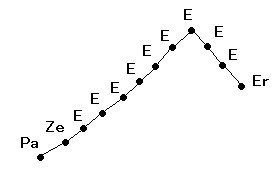Pazer
| Pazer | |||||||
|---|---|---|---|---|---|---|---|
| |||||||
| cantillation | |||||||
| Sof passuk | ׃ | paseq | ׀ | ||||
| etnakhta/atnakh | ֑ | segol | ֒ | ||||
| shalshelet | ֓ | zaqef qaton | ֔ | ||||
| zaqef gadol | ֕ | tifcha/tarkha | ֖ | ||||
| rivia/ravia’ | ֗ | zarqa | ֘ | ||||
| pashta | ֙ | yetiv | ֚ | ||||
| tevir | ֛ | geresh/gerish | ֜ | ||||
| geresh muqdam | ֝ | gershayim/shenei gerishin | ֞ | ||||
| karnei pharah | ֟ | telisha gedola/talsha | ֠ | ||||
| pazer (gadol) | ֡ | atnah hafukh | ֢ | ||||
| munakh/shofar holekh | ֣ | mahapakh/shofar mehupakh | ֤ | ||||
| merkha/ma’arikh | ֥ | merkha kefula/terei ta’amei | ֦ | ||||
| darga | ֧ | qadma | ֨ | ||||
| telisha qetana/tarsa | ֩ | yerah ben yomo | ֪ | ||||
| ole | ֫ | illuy | ֬ | ||||
| dehi | ֭ | zinor | ֮ | ||||
Pazer (Hebrew: פָּזֵר) is a cantillation mark found in the Torah, Haftarah, and other books of the Hebrew Bible. The pazer is generally followed by a Telisha ketana or gedola; on rare occasions when it is followed by another Pazer.
The Pazer is used to prolong a word significantly during the reading.[1] This places strong emphasis on the meaning of the particular word.[2]
The Hebrew word פָּזֵ֡ר translates into English as distribute or disseminate. This relates to the high number of notes in its melody. In a mystical interpretation, it shows the distribution of divinity.[3]
Total occurrences[edit]
| Book | Number of appearances |
|---|---|
| Torah | 154[4] |
| Genesis | 29[4] |
| Exodus | 29[4] |
| Leviticus | 27[4] |
| Numbers | 36[4] |
| Deuteronomy | 33[4] |
| Nevi'im | 177[5] |
| Ketuvim | 284[5] |
Melody[edit]
References[edit]
- ^ Tuning the Soul: Music As a Spiritual Process in the Teachings of Rabbi ... By Chani Haran Smith, page 29
- ^ Tit'haru! By Avigdor Nebentsal, page 162
- ^ A river flows from Eden: the language of mystical experience in the Zohar By Melila Hellner-Eshed, page 264-65
- ^ a b c d e f Concordance of the Hebrew accents in the Hebrew Bible: Concordance ..., Volume 1 By James D. Price, page 6
- ^ a b Concordance of the Hebrew accents in the Hebrew Bible: Concordance ..., Volume 1 By James D. Price, page 5

